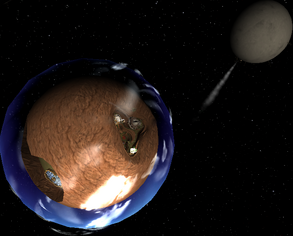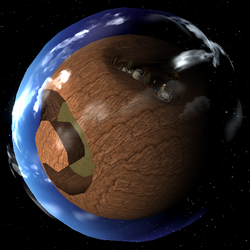(→Bugs: Probe trick also works with the ship itself, not only model ship) Tag: Visual edit |
|||
| (24 intermediate revisions by 11 users not shown) | |||
| Line 1: | Line 1: | ||
| + | {{Infobox_location|image = Timber Hearth.png|imagewidth = 250px|title = Timber Hearth|type = Planet|location = 2nd Planet from Sun|inhabitants = 9 Timber Hearthians|database info = |
||
| − | [[File:Placeholder|video|right|300px]] [[File:Placeholder|right|300px]] |
||
| ⚫ | |||
| ⚫ | |||
| ⚫ | |||
| ⚫ | |||
| + | [[File:Timberhearth and moon.png|thumb|293x293px|Timber Hearth and its Moon.]] |
||
| + | {{Alpha}} |
||
| ⚫ | '''Timber Hearth''' is the home planet of the player's species. It has an entirely rocky composition, with no liquid water on its surface. The terrain varies little aside from large craters, one of which forms the area of the [[village]]. It has a [[Sky Shutter|satellite]] and one [[moon]] orbiting it. Sometimes, the [[Quantum Moon]] may appear to orbit Timber Hearth. |
||
| + | ==Description== |
||
| + | Timber Hearth is the starting world where the player initially spawns, and is the location of the few tutorials the player can optionally choose to partake in as they explore the village. Timber Hearth also has a teleporter receiver on its surface (the funny looking blue star pattern near one of the poles). |
||
| − | ==Basic info== |
||
| + | The [[Observatory]] is a building present where players can examine and read about various artifacts and relics, as well as locate a map of the current star system the game takes place in, which can be found in the center of the Observatory, right beside the Curator npc who has the launch codes. |
||
| + | Another feature is the Zero-G Cave, which is exactly what it sounds like; a location where players can practice jetpack maneuvering in zero-g environments whilst repairing a fake satellite. This mechanic is used to teach players how to exit their ship in deep space, maneuver to a certain spot on the exterior, and repair the ship should it become damaged and have no landing zone available nearby. |
||
| + | There are several characters that you can interact with, which provide anything from showing you how to use your telescope to listen for sounds on distant celestial bodies, to a model space ship players can fly to get a handle on how to control their own ship once they are ready for launch. |
||
| + | == Bugs == |
||
| ⚫ | |||
| + | * If you shoot a probe at your ship or the model space ship, depending on where the probe lands on it, the probe model will be anywhere from slightly to vastly stretched and contorted, but still fully functional, as long as you are not currently piloting the model space ship. |
||
| − | |||
| + | * If you start a new expedition, but do not collect the launch codes from the Curator in the Observatory for more than 18 minutes, the sun will not explode, but the system map in the Observatory will have a glitched view where all planets and bodies are invisible, but still marked and titled, as well as the orbit paths following the camera pan, instead of staying put to match the celestial body locations. Your telescope will also refuse to be pulled out/put away if you are looking straight up, and will only function at an angle slightly under. |
||
| − | ==Database info== |
||
| + | {{Planets}} |
||
| ⚫ | |||
| + | [[Category:Planets]] |
||
| ⚫ | |||
| + | [[Category:Locations]] |
||
| ⚫ | |||
| ⚫ | |||
| − | |||
| − | ==Features== |
||
| − | |||
| − | The planet has a teleporter on its surface (the funny looking blue thing near one of the poles), and is the location of the tutorials. |
||
| − | The Observatory is present, in which players can examine and read about various artefacts and relics. There is also a map in the centre. |
||
| − | Another feature is the so called "Zero G Cave", which is exactly what it sounds like. |
||
| − | There are certain characters that you can interact with, as well as a model space ship to fly. |
||
Latest revision as of 16:36, 31 March 2018

Timber Hearth and its Moon.
Timber Hearth is the home planet of the player's species. It has an entirely rocky composition, with no liquid water on its surface. The terrain varies little aside from large craters, one of which forms the area of the village. It has a satellite and one moon orbiting it. Sometimes, the Quantum Moon may appear to orbit Timber Hearth.
Description
Timber Hearth is the starting world where the player initially spawns, and is the location of the few tutorials the player can optionally choose to partake in as they explore the village. Timber Hearth also has a teleporter receiver on its surface (the funny looking blue star pattern near one of the poles). The Observatory is a building present where players can examine and read about various artifacts and relics, as well as locate a map of the current star system the game takes place in, which can be found in the center of the Observatory, right beside the Curator npc who has the launch codes. Another feature is the Zero-G Cave, which is exactly what it sounds like; a location where players can practice jetpack maneuvering in zero-g environments whilst repairing a fake satellite. This mechanic is used to teach players how to exit their ship in deep space, maneuver to a certain spot on the exterior, and repair the ship should it become damaged and have no landing zone available nearby. There are several characters that you can interact with, which provide anything from showing you how to use your telescope to listen for sounds on distant celestial bodies, to a model space ship players can fly to get a handle on how to control their own ship once they are ready for launch.
Bugs
- If you shoot a probe at your ship or the model space ship, depending on where the probe lands on it, the probe model will be anywhere from slightly to vastly stretched and contorted, but still fully functional, as long as you are not currently piloting the model space ship.
- If you start a new expedition, but do not collect the launch codes from the Curator in the Observatory for more than 18 minutes, the sun will not explode, but the system map in the Observatory will have a glitched view where all planets and bodies are invisible, but still marked and titled, as well as the orbit paths following the camera pan, instead of staying put to match the celestial body locations. Your telescope will also refuse to be pulled out/put away if you are looking straight up, and will only function at an angle slightly under.
| Planets |
|---|
| Sun - Hourglass Twins - Timber Hearth / Moon - Brittle Hollow / Devil's Furnace Giant's Deep - Dark Bramble - The Wanderer - Quantum Moon |

